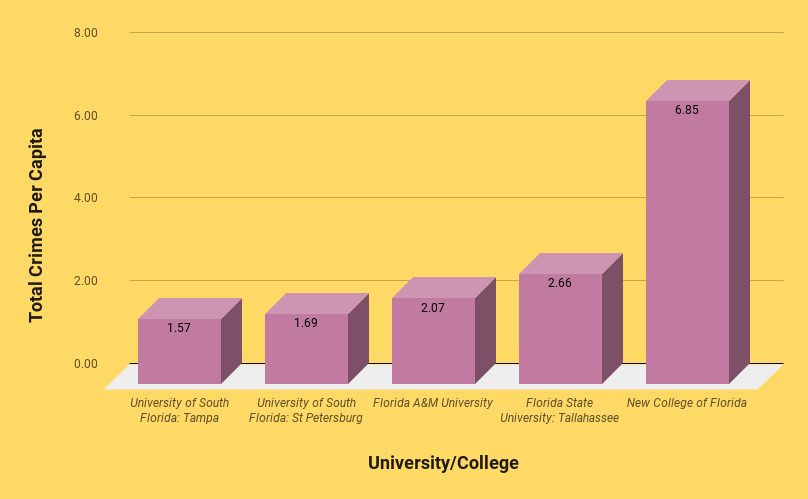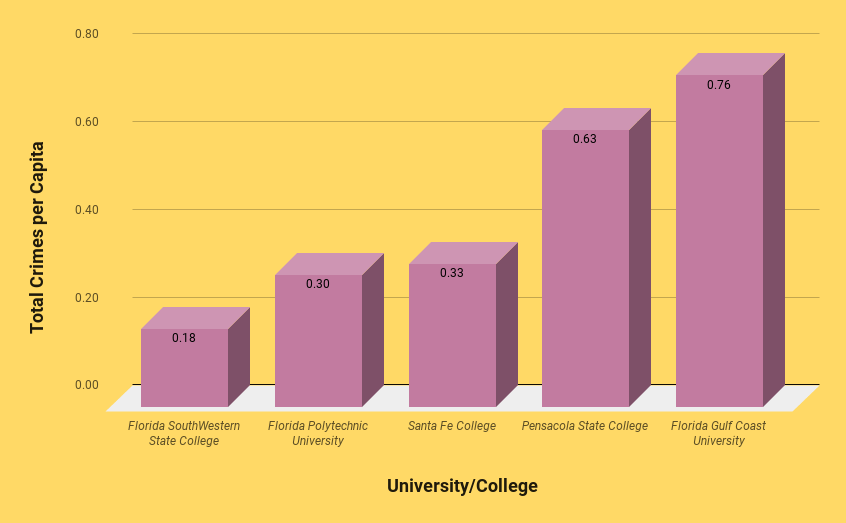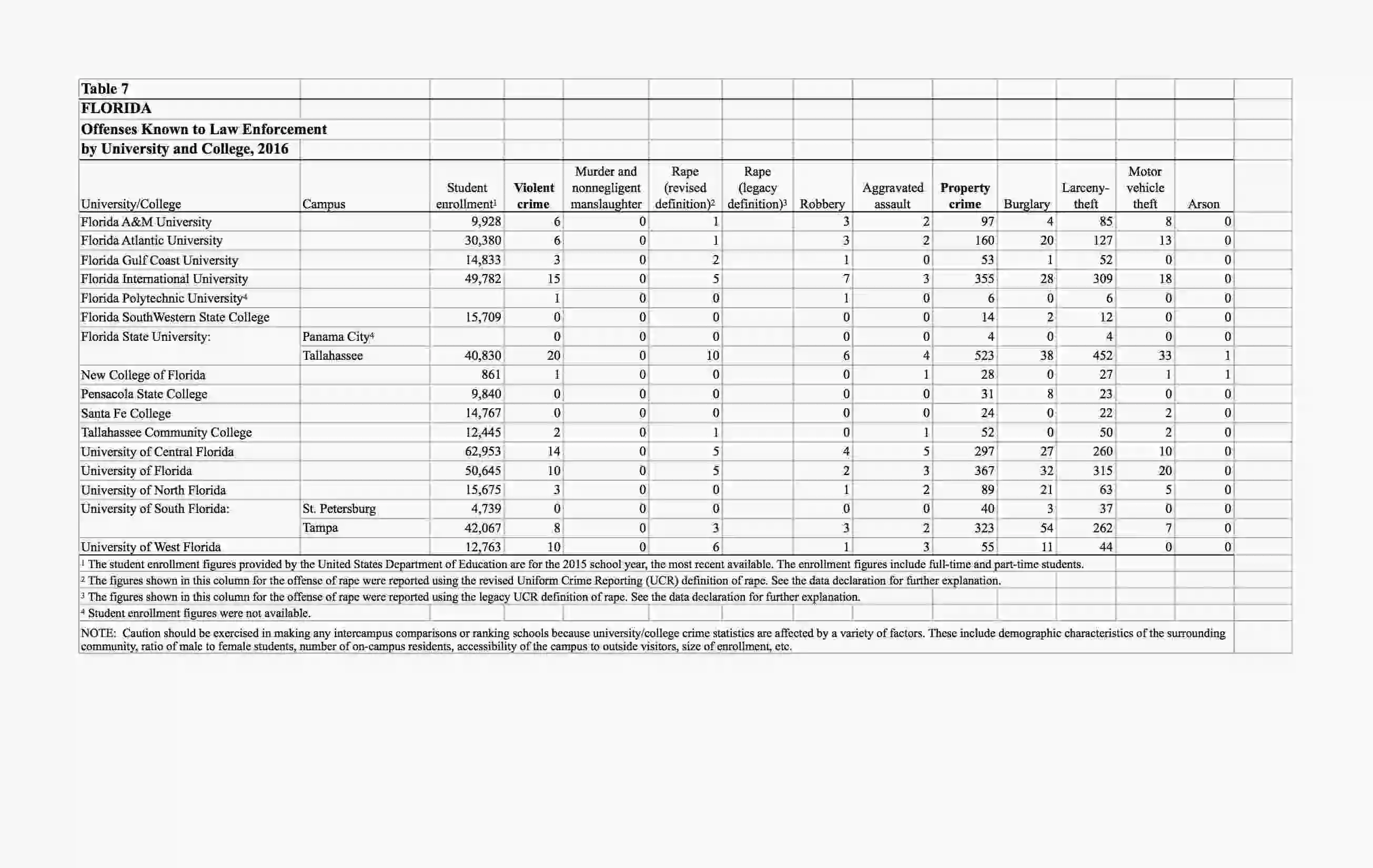Crime Rates Among Florida Colleges & Universities
When applying to college, most teenagers and parents tend to focus on a school’s location, degree offerings and cost. Very rarely is the crime rate considered, but should it be?
College campuses are expected to be relatively safe, but depending on which school you attend, the crime rates can be a bit daunting. If you, or a family member, are considering attending college in Florida, then you might be interested in learning about the various crimes committed at some of Florida’s prominent schools, which campuses have the most, and which have the least number of reported crimes per capita.
Florida Colleges Participating in UCR Program with Most Criminal Offenses Per Capita

In 2016, the FBI released crime statistics for 18 colleges and universities in Florida that participated in the Uniform Crime Reporting (UCR) program. It’s important to note that not all of Florida’s colleges/universities are represented in this article. Rather, only those whose law enforcement agencies submitted 12 months of complete offense data in 2016 to the UCR program.
 Based on the data collected by the FBI, New College of Florida had the highest recorded crime rate of any college or university that submitted crime statistics to the UCR. The school, which has a population of just 861 students had 6.85 crimes *per capita (6.85 crimes per 100 students).
Based on the data collected by the FBI, New College of Florida had the highest recorded crime rate of any college or university that submitted crime statistics to the UCR. The school, which has a population of just 861 students had 6.85 crimes *per capita (6.85 crimes per 100 students).
Next on the list was Florida State University Tallahassee, which had 2.66 crimes per capita. Florida A&M University had 2.07 crimes per capita, University of South Florida St. Petersburg had 1.69 crimes per capita, and finally University of South Florida Tampa had 1.57 crimes per capita.
Florida Colleges Participating in UCR Program with Fewest Criminal Offenses Per Capita

 So which schools had the lowest reported crime rates? Topping the list as one of the safest colleges in Florida was Florida SouthWestern State University, with a mere 0.18 offenses per capita. Go Bucs!
So which schools had the lowest reported crime rates? Topping the list as one of the safest colleges in Florida was Florida SouthWestern State University, with a mere 0.18 offenses per capita. Go Bucs!
In second place was Florida Polytechnic University, with only 0.30 offenses per capita. Santa Fe College had 0.33 offenses per capita. Next was Pensacola State College, with 0.63 offenses per capita. Rounding out the top five was Florida Gulf Coast University, with 0.76 offenses per capita.
Understanding the Crime Data
Insights
- Violent Crimes: FSU Tallahassee has the highest number of violent crimes (per 100 students). None of the colleges, however, had any incidents of murder or manslaughter.
- Rape: Eight of the colleges had no incidents of rape in 2016. The others had six or fewer incident except for Florida State University Tallahassee, which had 10 incidents of rape reported.
- Robbery: Robbery (done with physical force) was not common on any of the college campuses. Seven of the colleges had no incidents reported. Florida International University had the highest number of robberies, with seven incidents.
- Aggravated Assault: University of Central Florida had the highest number of aggravated assault, at five. Property crime was a common occurrence at most of the schools. Florida State University Panama City had the lowest rate, at just four incidents. Florida Polytechnic University had only six incidents.
- Burglary: Five colleges reported no burglary incidents (unlawful entry into a home or business with intent to commit robbery inside). University of South Florida Tampa had the most, with 54 incidents.
- Larceny: Larceny (or theft of personal property) was common among all schools, with Florida State University Tallahassee leading the way at 452 incidents. At the other end of the spectrum was Florida State University Panama City, with just four total incidents.
- Vehicle Theft: Seven colleges reported no vehicle thefts. Florida State University Tallahassee, again, led the way with 33 total incidents. Arson was not common on college campuses. Just one incident was reported each at Florida State University Tallahassee and New College of Florida.
How Does This Affect Prospective College Students?
Safety should be a consideration for prospective college students. However, understand that university and college crime statistics are affected by multiple factors. Crime rates may be influenced by demographics, density of campus residents, ratio of male to female students and accessibility of the campus to outside visitors. Additionally, crime statistics at college campuses are undoubtedly inaccurate since some criminal acts go unreported. This can cause crime data to be misrepresented, and a particular campus may seem safer or more crime-ridden than it really is.
If you have concerns about the safety of a certain school, discuss them with administration. Talk to current students and faculty. This will allow you to get a better idea of any safety issues.
*Per capita was calculated by taking the total number of offenses, dividing that number by student enrollment and then multiplying by 100 to get the number of crimes committed per 100 students.
[shareaholic app=”share_buttons” id=”20604036″]
